Besançon
Besançon (UK: /ˈbɛzənsɒn/,[2] US: /bɪˌzɒ̃ˈsoʊn, bɪˈzænsən/,[3][4] French: [bəzɑ̃sɔ̃] (![]()
Besançon | |
|---|---|
Prefecture and commune | |
   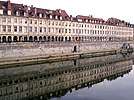 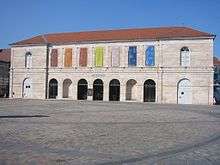   Clockwise from top: the citadel, the tramway in Battant, an aerial view of the oxbow of the Doubs river, the Vauban quay, the Museum of Fine Arts and Archeology, the parc de la Gare-d'Eau, the Porte Noire and St. John's Cathedral, the Granvelle Palace. | |
 Flag 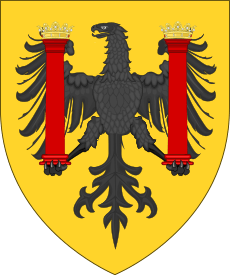 Coat of arms | |
| Motto(s): Plût A Dieu ("If God wills") or Utinam | |
Location of Besançon 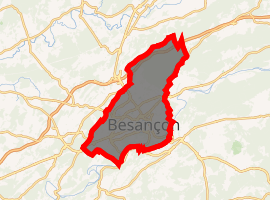
| |
 Besançon 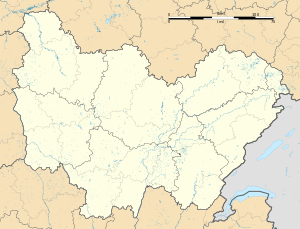 Besançon | |
| Coordinates: 47°14′24″N 6°1′12″E | |
| Country | France |
| Region | Bourgogne-Franche-Comté |
| Department | Doubs |
| Arrondissement | Besançon |
| Canton | Besançon-1, 2, 3, 4, 5 and 6 |
| Intercommunality | Grand Besançon Métropole |
| Government | |
| • Mayor (2014–2020) | Jean-Louis Fousseret (La République En Marche!) |
| Area 1 | 65.05 km2 (25.12 sq mi) |
| • Urban (2016) | 122 km2 (47 sq mi) |
| • Metro (2016) | 1,652 km2 (638 sq mi) |
| Population (2017-01-01)[1] | 115,934 |
| • Rank | 31st in France |
| • Density | 1,800/km2 (4,600/sq mi) |
| • Urban (2016) | 135,349 |
| • Urban density | 1,100/km2 (2,900/sq mi) |
| • Metro (2016) | 251,293 |
| • Metro density | 150/km2 (390/sq mi) |
| Time zone | UTC+01:00 (CET) |
| • Summer (DST) | UTC+02:00 (CEST) |
| INSEE/Postal code | 25056 /25000 |
| Website | http://www.besancon.fr/ |
| 1 French Land Register data, which excludes lakes, ponds, glaciers > 1 km2 (0.386 sq mi or 247 acres) and river estuaries. | |
Capital of the historic and cultural region of Franche-Comté, Besançon is home to the Bourgogne-Franche-Comté regional council headquarters, and is an important administrative centre in the region. It is also the seat of one of the fifteen French ecclesiastical provinces and one of the two divisions of the French Army.
In 2016 the city had a population of 120,107, in a metropolitan area of 251,293, the second in the region in terms of population.
Established in a meander of the Doubs river, the city was already important during the Gallo-Roman era under the name of Vesontio, capital of the Sequani. Its geography and specific history turned it into a military stronghold, a garrison city, a political center, and a religious capital.
Besançon is the historical capital of watchmaking in France. This has led it to become a center for innovative companies in the fields of microtechnology, micromechanics, and biomedical engineering. The University of Franche-Comté, founded in 1423, every year enrolls more than 20,000 students; its Centre for Applied Linguistics enrolls another estimated 4,000 trainees from all over the world.
The greenest city in France,[5] it enjoys a quality of life recognized in Europe. Thanks to its rich historical and cultural heritage and its unique architecture, Besançon has been labeled a "Town of Art and History" since 1986 and its fortifications due to Vauban has been listed as a UNESCO World Heritage site since 2008.
History
Toponymy
The city is first recorded in 58 BC as Vesontio in the Book I of Julius Caesar's Commentarii de Bello Gallico. The etymology of Vesontio is uncertain. The most common explanation is that the name is of Celtic origin, derived from wes, meaning 'mountain'. During the 4th century, the letter B took the place of the V, and the city name changed to Besontio or Bisontion and then underwent several transformations to become Besançon in 1243.
Ancient history
The city sits within an oxbow of the Doubs River (a tributary of the Saône River); a mountain closes the fourth side. During the Bronze Age, c.1500 BC, tribes of Gauls settled the oxbow.
From the 1st century BC through the modern era, the town had a significant military importance because the Alps rise abruptly to its immediate south, presenting a significant natural barrier.
The Arar (Saône) River formed part of the border between the Haedui and their hereditary rivals, the Sequani.[6] According to Strabo, the cause of the conflict was commercial.[7] Each tribe claimed the Arar and the tolls on trade along it. The Sequani controlled access to the Rhine River and had built an oppidum (a fortified town) at Vesontio to protect their interests. The Sequani defeated and massacred the Haedui at the Battle of Magetobriga, with the help of the Arverni tribe and the Germanic Suebi tribe under the Germanic king Ariovistus.
Julius Caesar, in his commentaries detailing his conquest of Gaul, describes Vesontio (possibly Latinized), as the largest town of the Sequani, a smaller Gaulic tribe, and mentions that a wooden palisade surrounded it.
Over the centuries, the name permutated to become Besantio, Besontion, Bisanz in Middle High German, and gradually arrived at the modern French Besançon. The locals retain their ancient heritage referring to themselves as Bisontins (feminine: Bisontine).
It has been an archbishopric since the 4th century.
Middle Ages
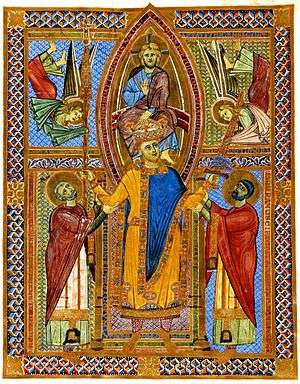
In 843, the Treaty of Verdun divided up Charlemagne's empire. Besançon became part of Lotharingia, under the Duke of Burgundy.
As part of the Holy Roman Empire since 1034, the city became an archbishopric, and was designated the Free Imperial City of Besançon (an autonomous city-state under the Holy Roman Emperor) in 1184. In 1157, Emperor Frederick Barbarossa held the Diet of Besançon. There, Cardinal Orlando Bandinelli (the future Pope Alexander III, then adviser of Pope Adrian IV) openly asserted before the Emperor that the imperial dignity was a papal beneficium (in the more general sense of favour, not the strict feudal sense of fief), which incurred the wrath of the German princes. He would have fallen on the spot under the battle-axe of his lifelong foe, Otto of Wittelsbach, had Frederick not intervened. The Imperial Chancellor Rainald of Dassel then inaugurated a German policy that insisted upon the rights and the power of the German kings, the strengthening of the Church in the German Empire, the lordship of Italy and the humiliation of the Papacy. The Archbishops were elevated to Princes of the Holy Roman Empire in 1288. The close connection to the Empire is reflected in the city's coat of arms.
In 1290, after a century of fighting against the power of the archbishops, the Emperor granted Besançon its independence.
Renaissance
In the 15th century, Besançon came under the influence of the dukes of Burgundy. After the marriage of Mary of Burgundy to Maximilian I, Holy Roman Emperor, the city was in effect a Habsburg fief. In 1519 Charles V, Holy Roman Emperor, King of Spain, became the Holy Roman Emperor. This made him master of the Franche-Comté and Besançon, a francophone imperial city. In 1526 the city obtained the right to mint coins, which it continued to strike until 1673. Nevertheless, all coins bore the name of Charles V.
When Charles V abdicated in 1555, he gave the Franche-Comté to his son, Philip II, King of Spain. Besançon remained a free imperial city under the protection of the King of Spain. In 1598, Philip II gave the province to his daughter on her marriage to an Austrian archduke. It remained formally a portion of the Empire until its cession at the peace of Westphalia in 1648. Spain regained control of Franche-Comté and the city lost its status as a free city. Then in 1667, Louis XIV claimed the province as a consequence of his marriage to Marie-Thérèse of Spain in the War of Devolution.
Louis conquered the city for the first time in 1668, but the Treaty of Aix-la-Chapelle returned it to Spain within a matter of months. While it was in French hands, the famed military engineer Vauban visited the city and drew up plans for its fortification. The Spaniards built the main centre point of the city's defences, "la Citadelle", siting it on Mont Saint-Étienne, which closes the neck of the oxbow that is the site of the original town. In their construction, the Spaniards followed Vauban's designs.
In 1674, French troops recaptured the city, which the Treaty of Nijmegen (1678) then awarded to France. At this time the city became the administrative centre for the Franche-Comté, with its own Parlement of Besançon, which replaced Dole.
As a result of control passing to France, Vauban returned to working on the citadel's fortifications, and those of the city. This process lasted until 1711, some 30 years, and the walls built then surround the city. Between the train station and the central city there is a complex moat system that now serves road traffic. Numerous forts, some of which date back to that time and that incorporate Vauban's designs elements sit on the six hills that surround the city: Fort de Trois Châtels, Fort Chaudanne, Fort du Petit Chaudanne, Fort Griffon, Fort des Justices, Fort de Beauregard and Fort de Brégille. The citadel itself has two dry moats, with an outer and inner court. In the evenings, the illuminated Citadelle stands above the city as a landmark and a testament to Vauban's genius as a military engineer.
Modern Europe
In 1814, the Austrians invaded and bombarded the city. It also occupied an important position during the Franco-Prussian War of 1870–71.
The Nazis occupied the citadel during World War II. Between 1940 and 1944, the Germans executed some one hundred French resistance fighters there. However, Besançon saw little action during the war. The allies bombed the railway complex in 1943, and the next year the Germans resisted the U.S. advance for four days.
Besançon was also the location, between 1940 and 1941, of an Internment Camp (Konzentrationslager), Frontstalag 142, also known as Caserne Vauban, which the Germans set up for 3–4,000 holders of British passports, all women and children. The conditions were harsh; many hundreds of internees died of pneumonia, diarrhea, food poisoning, dysentery, and frostbite.[8]
In 1959, the French Army turned the citadel over to the city of Besançon, which turned it into a museum.
The forts of Brégille and Beauregard sit across the Doubs from the city. In 1913, a private company built a funicular to the Brégille Heights. The funicular passed from private ownership to the SNCF, who finally closed it in 1987. The funicular's tracks, stations and even road signs remain in place to this day.
Geography
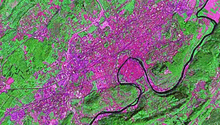

Location
Besançon is located in the north-east quarter of France on the Doubs River. It is about 325 kilometres (202 miles) east of the national capital of Paris, 100 kilometres (62 miles) east of Dijon in Burgundy, 125 km (78 mi) northwest of Lausanne in Switzerland, and 100 km (62 mi) southwest of Belfort in Bourgogne-Franche-Comté. It is located at the edge of the Jura Mountains.
Topography
The city initially developed in a natural meander (or oxbow loop) of the Doubs River with a diameter of almost 1,000 metres (3,281 feet). The flat inner loop has an elevation of about 250 metres (820 feet), and is bounded to the south by a hill called Mont Saint-Étienne, which has a maximum height of 371 metres (1,217 feet). The city is surrounded by six other hills which range in elevation from 400 to 500 metres (1,312 to 1,640 feet): Brégille, Griffon, Planoise, Chaudanne, Montfaucon, and Montboucon. (There is a barge canal that cuts through rock under Mont Saint-Étienne, short-cutting the meander.)
Climate
Besançon is under the influence of both an oceanic climate (notable precipitations in quantity as much as in frequency) and a continental climate with hard winters (snow, frost) and warm and dry summers. The year-round average is 11.5 °C (53 °F). The warmest month is July 20 °C (68 °F) and the coldest is January 2.1 °C (36 °F). Besançon receives about 1,059 mm (42 in) of precipitation per year. The wettest month is May (108.4 mm (4.3 in)); the driest is August (76.9 mm (3.0 in)). The highest temperature ever, recorded on 28 July 1921, was 40.3 °C (104.5 °F), and the lowest was a −20.7 °C (−5.3 °F) reached on 1 January 1985.
| Climate data for Besançon, elevation: 307 m (1,007 ft), 1981–2010 normals, extremes 1884–present | |||||||||||||
|---|---|---|---|---|---|---|---|---|---|---|---|---|---|
| Month | Jan | Feb | Mar | Apr | May | Jun | Jul | Aug | Sep | Oct | Nov | Dec | Year |
| Record high °C (°F) | 16.8 (62.2) |
21.7 (71.1) |
24.8 (76.6) |
29.1 (84.4) |
32.2 (90.0) |
35.8 (96.4) |
40.3 (104.5) |
38.3 (100.9) |
34.6 (94.3) |
30.1 (86.2) |
23.0 (73.4) |
20.8 (69.4) |
40.3 (104.5) |
| Average high °C (°F) | 5.2 (41.4) |
7.0 (44.6) |
11.4 (52.5) |
15.2 (59.4) |
19.5 (67.1) |
22.8 (73.0) |
25.3 (77.5) |
25.0 (77.0) |
20.7 (69.3) |
16.0 (60.8) |
9.5 (49.1) |
5.7 (42.3) |
15.3 (59.5) |
| Daily mean °C (°F) | 2.3 (36.1) |
3.4 (38.1) |
7.0 (44.6) |
10.2 (50.4) |
14.4 (57.9) |
17.6 (63.7) |
19.9 (67.8) |
19.5 (67.1) |
15.8 (60.4) |
11.8 (53.2) |
6.2 (43.2) |
3.1 (37.6) |
11.0 (51.8) |
| Average low °C (°F) | −0.7 (30.7) |
−0.2 (31.6) |
2.7 (36.9) |
5.2 (41.4) |
9.3 (48.7) |
12.4 (54.3) |
14.5 (58.1) |
14.1 (57.4) |
10.9 (51.6) |
7.6 (45.7) |
2.9 (37.2) |
0.4 (32.7) |
6.6 (43.9) |
| Record low °C (°F) | −20.7 (−5.3) |
−20.6 (−5.1) |
−14.0 (6.8) |
−5.2 (22.6) |
−2.4 (27.7) |
2.1 (35.8) |
4.5 (40.1) |
3.4 (38.1) |
−0.1 (31.8) |
−6.1 (21.0) |
−11.3 (11.7) |
−19.3 (−2.7) |
−20.7 (−5.3) |
| Average precipitation mm (inches) | 86.3 (3.40) |
79.7 (3.14) |
92.0 (3.62) |
94.2 (3.71) |
114.8 (4.52) |
101.5 (4.00) |
90.0 (3.54) |
91.9 (3.62) |
107.2 (4.22) |
115.7 (4.56) |
104.5 (4.11) |
109.2 (4.30) |
1,187 (46.73) |
| Average precipitation days (≥ 1.0 mm) | 13.0 | 11.6 | 12.1 | 11.5 | 13.4 | 11.1 | 10.2 | 10.0 | 9.8 | 12.5 | 12.6 | 13.4 | 141.0 |
| Average relative humidity (%) | 87 | 82 | 77 | 74 | 77 | 77 | 75 | 78 | 82 | 87 | 87 | 88 | 81 |
| Mean monthly sunshine hours | 75.1 | 95.5 | 142.1 | 176.1 | 206.6 | 230.4 | 244.1 | 232.3 | 175.8 | 132.6 | 72.7 | 53.0 | 1,836.4 |
| Source 1: Meteo France[9][10] | |||||||||||||
| Source 2: Infoclimat.fr (relative humidity 1961–1990)[11] | |||||||||||||
Neighborhoods
|
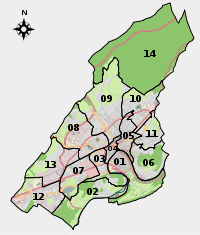 |
Population
As of the French Census of 2016, the population of the City of Besançon was 116,466, lower than the historical peak of 120,315 in 1975. Grand Besançon Métropole covers 528.6 km2 (204.1 sq mi), 68 municipalities and has a population of 193,187. The metropolitan area covers 1,890.9 km2 (730.1 sq mi), 254 municipalities and has 251,293 inhabitants. It is the 42nd of France, and it increased by 2.6% between 2010 and 2016.
| Historical population | |||||||||||||||||||||||||||||||||||||||||||||||||||||||||||||||||||||||||||
|---|---|---|---|---|---|---|---|---|---|---|---|---|---|---|---|---|---|---|---|---|---|---|---|---|---|---|---|---|---|---|---|---|---|---|---|---|---|---|---|---|---|---|---|---|---|---|---|---|---|---|---|---|---|---|---|---|---|---|---|---|---|---|---|---|---|---|---|---|---|---|---|---|---|---|---|
|
|
|
| ||||||||||||||||||||||||||||||||||||||||||||||||||||||||||||||||||||||||
| Source: | |||||||||||||||||||||||||||||||||||||||||||||||||||||||||||||||||||||||||||
Government and politics
Until 2016, Besançon was the capital of the Franche-Comté administrative région of France, a région including the four départements of Doubs, Haute-Saône, Jura and Territoire de Belfort. Franche-Comté was since merged with the neighbouring region of Burgundy, and the "préfecture" was transferred to the city of Dijon. However, Besançon remains the seat of the Bourgogne-Franche-Comté regional council and of various decentralised administrations such as the regional offices of the French National Institute for Statistics and Economic Studies (INSEE) or the Centre régional des œuvres universitaires et scolaires (CROUS).
Mayor of the City of Besançon is Jean-Louis Fousseret (La République En Marche!).
Economy
The city is famous for its microtechnology and watch industries. It is host of the biannual Micronora trade fair, one of Europe's major events in the field of microtechnologies. The city has a little-known specialty, automatic ticketing machines for car parking, airports, date stamping etc.
The watch industry, for which Besançon remains the French capital, endured a major crisis in the 1970s when the advent of quartz watches from Asia knocked out the traditional watch industry in the space of just a few years. The famous "Lip" affair epitomizes the industrial crisis. LIP is to this day the name of one of Besançon's most prestigious brands of watches. Refusing to let their factory close, the workers set up a cooperative to run it. The action produced a lot of notoriety and sympathy for the workers but also resulted in branding Besançon as a city of the radical left. It also did nothing to help revive the watch industry; the cooperative went out of business a short while later. The city took a long time to recover from the collapse of the watch industry and its other major industry of the industrial age, artificial textiles.
Since the 1980s, Besançon's watch industry has clawed its way back on the basis of its historic reputation and quartz watches, establishing itself in a number of niche markets including customized watches, high quality watches, and fashion articles. Since the 1990s, the town has developed a reputation as one of France's leading centres of technology in all fields, including telecommunications and biotechnology.
Education
Besançon is the seat of the Université de Franche-Comté. As of 2018, there were approximately 24,000 students enrolled at the university, including around 3,000 foreign students. The Institut Supérieur d'Ingénieurs de Franche-Comté[12] (ISIFC), part of the Université de Franche-Comté, is the first school created in the country specifically for the Biomedical engineering field. The city is also home of the École Nationale Supérieure de Mécanique et des Microtechniques (ENSMM), a technological school with a strong reputation in the fields of microtechnology and mechanics and the worldwide famous Centre for Applied Linguistics which teaches ten languages to non-native speakers (French, Arabic, Chinese, English, German, Italian, Japanese, Portuguese, Russian, Spanish) and any other known language on request. The Centre welcomes more than 4,000 students every year from all over the world. As well as being famed as one of France's finest "villes d'art" (art cities), Besançon is the seat of one of France's older universities, of France's National School of Mechanics and Micromechanics, and one of the best known French language schools in France, the CLA.
Landmarks
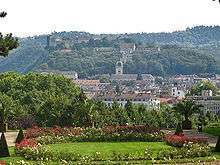
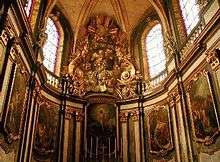
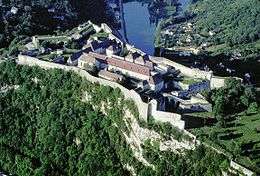
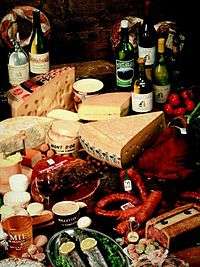
.jpg)
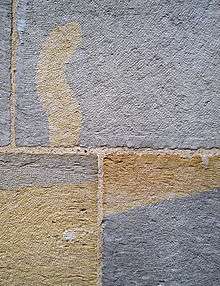
The city has one of the most beautiful historic centers of any major town in France. A broad horse-shoe of the river Doubs, "la Boucle", encircles the old town, while Vauban's imposing Citadelle blocks off the neck. The historic center presents a remarkable ensemble of classic stone buildings, some dating back to the Middle Ages and others to the Spanish Renaissance.
Gallo-Roman remains
The Roman remains consist primarily of the Porte Noire, a 2nd-century CE triumphal arch at the foot of the hill on which the citadel stands, and the Square Castan, a semi-circular amphitheater. The Porte Noire may commemorate the victories of Marcus Aurelius over the Germans in 167 CE. It was partly rebuilt in 1820.
Fortifications and military buildings
UNESCO added the citadel, the city walls, and Fort Griffon to its list of World Heritage Sites in 2008, as part of the "Fortifications of Vauban" group. Some older military architecture has also survived. There is a cylindrical, 15th-century tower near the Porte Notre-Dame, the southern gate of the city. The Porte Rivotte, a 16th-century gate, has two round towers. The citadel houses the Museum of the French Resistance and Deportation.
Places of worship
The Cathedral, which dates largely from the 12th century[13] though construction continued into the 14th century, contains the most remarkable of the city's masterpieces, a massive Virgin and saints altarpiece by the Italian Renaissance painter Fra Bartolomeo. It also houses a noteworthy 19th-century astronomical clock. The Cathedral has two apses, with the eastern apse and the tower dating from the reign of Louis XV.
Government and residentials buildings
From 1534 to 1540, Cardinal Granvelle, chancellor to the Habsburg emperor Charles V, built the Palais Granvelle, in the heart of the town.[14][15] It consists of arcades that surround an interior court, and is the most interesting of the secular buildings. The Palais contains a set of seven wool and silk blend tapestries from Bruges that were woven circa 1635 and that celebrate seven milestones in Charles V's life. These tapestries remained in Spain until 1888, when they were transferred to France. In 1950 they were transferred to the Palais.
Attractive quays border the old city, and in places there are shady promenades. On the right bank there is a bathing establishment in the Mouillere quarter that draws its water from the saline springs of Miserey-Salines.
- Besançon Astronomical Observatory
- several Spanish Renaissance-style buildings
Parks and gardens
With 5,950 acres (9.30 sq mi; 24.1 km2) of urban open spaces, including 4,942 acres (7.722 sq mi; 20.00 km2) of forests, Besançon is considered the first green city in France with 204 m2 of green spaces per capita. The Forest of Chailluz, covering 4,015 acres (6.273 sq mi; 16.25 km2), represents a quarter of the total area of the commune. The city is the owner of this mainly deciduous forest, which includes a wildlife park and a fitness trail in addition to numerous trails. The historic center is entirely surrounded by green spaces. To the west of the old town, on the left bank of the River Doubs, are the Jardins de la Gare-d'Eau: in 1833, the construction of the Rhone-Rhine Canal led the city to create a small port river shipping but it quickly fell into disuse after the opening of a canal tunnel under the citadel. The 5 acres (0.0078 sq mi; 0.020 km2) park around the basin is currently owned by the departmental council of Doubs. The Chamars Promenade, attached to these gardens but further north, built in the fourth quarter of the eighteenth century, owes its name to the contraction of Champ de Mars (Field of Mars). It was at first a marshland separated into two parts by an arm of the River Doubs: the big and the small Chamars. Vauban, judging this place vulnerable, fortified it with the help of ramparts and bastions. The city obtained permission to turn this space into a promenade in 1739. The architect Bertrand remodeled it between 1770 and 1778 by incorporating a café, public baths, an aviary of rare birds, waterfalls, a botanical garden and many plantings. It largely disappeared after 1830 with the leveling of the inner rampart and the creation of the Gare d'Eau port. A public garden was refurbished between 1978 and 1982. The only surviving elements of the former Chamars Promenade are the two guard houses, some plane trees, and the stone vases of the sculptor Jean-Baptiste Boutry.
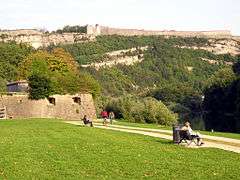 Jardins de la Gare d'Eau.
Jardins de la Gare d'Eau.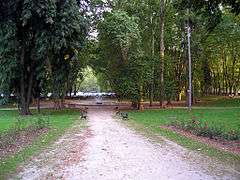 Promenade Chamars.
Promenade Chamars.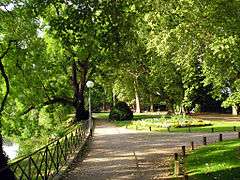 Promenade Micaud.
Promenade Micaud.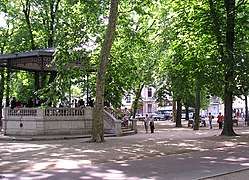 Promenade Granvelle.
Promenade Granvelle.
North of the historic district of Battant, on the right bank of the River Doubs, the Glacis Promenade, created in the middle of the nineteenth century, is the work of the landscape architect Brice Michel and the architect Boutterin. Right in the heart of this district, the Clos Barbisier is a garden created in 1988 and presenting an important variety of roses. The green belt extends east of the old town, still on the right bank of the River Doubs, by the Promenade of Helvetia which houses a botanical garden called Jardin des Sens et des Senteurs (Garden of Senses and Scents) realized in 1987, accessible to the visually impaired thanks to its plants and shrubs with certain sensory features (smell, touch), and Braille signs. Directly to the south is the Micaud Promenade, which has been progressively developed over 7 acres (0.011 sq mi; 0.028 km2) from 1843 on plans by architect Alphonse Delacroix. It is named after Jules Micaud, the mayor who promoted the project. It includes more than four hundred trees, including a southern magnolia and a European beech, a bandstand, a pond, and several sculptures. The Jardins du Casino, a public garden with flowering lawns and tree-lined avenues, is directly on the other side of Edouard Droz Avenue, which runs along Micaud Promenade.
In the heart of the historic center, the Promenade Granvelle is the former private garden of the sixteenth century Granvelle Palace, which the municipality acquired in 1712 and which was opened to the public in 1728. The architect Bertrand redeveloped it into a public garden from 1775 to 1778. It includes a bandstand, an artificial cave, a Wallace fountain, statues of Victor Hugo and Auguste Veil-Picard, the portal of the church of the convent of the Great Carmelites, and a neoclassical colonnade, a remnant of a refreshment pavilion. The first botanical garden in Besançon was created in 1580. It then occupied more than ten different sites, including the current location of Place Leclerc since 1957. The Parc de l'Observatoire, created in 1904 at the request of the director of the astronomical observatory Auguste Lebeuf, is home to a purple beech, a weeping beech, chestnut and pine trees.
Culture
Museums and galleries
There are five museums in Besançon that all bear the designation "Museum of France". Besançon has one of the finest city art galleries in France outside Paris. The Museum of Fine Arts and Archeology, created in 1694, was the first museum created in France and predates The Louvre by almost a century. It has benefited from a remarkable series of bequests over time.
In the 1960s the architect Luis Miquel, a pupil of Le Corbusier, totally rebuilt the building. The building's interior takes the form of a gently rising concrete walkway that takes visitors up from classical antiquity to the modern age. Among the museum's treasures are a fine collection of classical antiquities and ancient Egyptian artifacts, as well as a very rich collection of paintings including works by Bellini, Bronzino, Tintoretto, Titian, Rubens, Jordaens, Ruisdael, Cranach, Zurbarán, Goya, Philippe de Champaigne, Fragonard, Boucher, David, Ingres, Géricault, Courbet, Constable, Bonnard, Matisse, Picasso and many others.
The Musée du Temps (Museum of Time), inaugurated in 2002, was formerly the City's History Museum. Located in the Granvelle Palace, its concept is unique in Europe, grouping watch collections (watches, sundials, hourglasses, all means of measuring time ...) and the funds of the history museum (paintings, engravings). In addition, three museums are grouped inside the Vauban citadel
The Museum of Resistance and Deportation has been open since 1971 and is one of the largest in its category at the national level. It consists of twenty rooms, retracing the themes related to the Second World War (Nazism, the Occupation, the Vichy regime, the Resistance, Liberation, Deportation) through photographs, texts, documents and original collectibles. The establishment also has two rooms dedicated to artists whose works were made in concentration camps.
The Comtois Museum, installed in 1961 in the Royal Front, presents regional arts and traditions through sixteen permanent exhibition halls with collections of more than 20,000 objects, mainly from the nineteenth and early twentieth centuries.
The Museum of Natural History, created in 1959 under the leadership of Mayor Jean Minjoz, presents varied backgrounds in a small evolutionary course around collections of natural sciences (naturalized animals, herbaria ...); it also presents live animals in four sectors (zoo, insectarium, noctarium and aquarium). Besançon is also home to the birthplace of Victor Hugo, presenting the humanist political commitment of the famous writer. The Cité des Arts exhibits part of the works of the regional fund of contemporary art of Burgundy-Franche-Comté

Performing arts centers
The city is home to a National Center for Dramatic Art, the Centre dramatique national Besançon Franche-Comté created in 1972. This theater installed in the former ballroom of the Casino has a capacity of 337 seats. The Scène nationale de Besançon performs since 2012 in two facilities including the Théâtre de l'Espace and the Théâtre Ledoux. The Théâtre Ledoux was inaugurated in 1784 and can accommodate 1100 people. Besançon also has smaller structures. The Scénacle located in the Saint-Jean district is a small theater with a capacity of about 100 seats that offers plays and concerts by the troupe or regional artists. On campus, the 150-seat Petit Théâtre de la Bouloie welcomes student projects to promote artistic and cultural practice (university theater, university choir...), artistic residencies of young companies, professional shows proposed by the partner structures and shows of young companies.
The Kursaal is the result of the will to offer entertainment and shows to spa guests of the spa resort of Besançon-les-Bains created in 1891 and military garrison in the city. The Kursaal-Circus opened at the end of 1893, but the promoter's finances, Madame Veuve Pellegrin, did not allow her to reimburse the expenses incurred. The city acquired it in 1895 and the Kursaal became the city's concert hall. It closes in 1970 for reasons of obsolescence, before being renovated from 1979 and reopened in September 1982. A conference room with 360 seats, called Petit Kursaal was also created in the basement. The main hall, known as Grand Kursaal, has two balconies and a dome ceiling decorated with beautiful frescoes reminiscent of the circus arts. Its capacity can go up to 1,038 seats including 450 on both balconies.
Popular bands play throughout the year at La Rodia, located in the Prés-de-Vaux neighborhood. It includes a large 900-seat theater and a 330-seat "club" hall as well as two creative studios. The Micropolis Exhibition Center houses a modular hall with a capacity of 2,200 to 6,500 seats, where the majority of artists and bands on national and international tours are performing.
The city is home to the Victor Hugo Franche-Comté Orchestra.
Cinema
There are two multiplex cinemas, the Mégarama Beaux-Arts in the historic district and Mégarama École-Valentin in the suburban area. The Cinéma Victor-Hugo is a smaller cinema promoting indie movies, located in the city center.
Annual cultural events and fairs
The city of Besançon hosts many festive and cultural events.
Several music festivals punctuate the year, the most emblematic and the oldest of which is the Besançon Franche-Comté International Music Festival, created in 1948 and held every year in September. This festival honors the symphonic repertoire, chamber music and recitals. It was completed in 1951 by the International Contest of Young Conductors held every two years (odd years), one of the most prestigious of the discipline which counts among its laureates Seiji Ozawa, Gerd Albrecht, Michel Plasson or Zdeněk Mácal.
The Festival Détonation is another highlight of September: created in 2012 and organized by La Rodia, its programming mixes pop music, electronic music and interactive mapping installations.
Initiated in 2007, the GéNéRiQ Festival takes place in February in five cities: Belfort, Besançon, Dijon, Montbéliard and Mulhouse. Its programming is also focused on new musical trends such as electro clubbing, mediterranean surf, free metal, electro blues, alternative hip hop or neo ghetto folk.
Created in 1981, the Jazz and improvised music festival in Franche-Comté offers concerts in Besançon and other towns in the region in June.
The Circasismic Festival, held in May since 2015, presents a program of electro, dub and rock music as well as circus and street theater shows.
The Orgue en ville festival, created in 2009, offers about twenty concerts around the organ in religious buildings of Besançon and its agglomeration. It takes place between the end of June and the beginning of July.
The Besançon-Montfaucon Festival offers musical works played on period instruments.
The Foire Comtoise is a trade fair and a travelling funfair held in the Micropolis exhibition center. This event created in 1922 was originally an agricultural fair. It now hosts around 600 exhibitors and 140,000 visitors around the Feast of the Ascension weekend. Each year, a country or a community is a guest of honor and presents its crafts and its customs and traditions through shows.
Since 1995, the Gourmet Instants market has been held on the Granvelle Promenade in September and showcases local gastronomic products.
The Christmas market in Besançon has been spreading throughout December since 1993, while a carnival parade has been held since 1978, bringing together 20,000 to 30,000 people each year in the streets of the city center.
The Grand Besançon Métropole book festival (Livres dans la Boucle) take place in September. Running over three days, it hosted in 2018 more than 200 authors and 30,000 visitors.
An African cinema festival called Lumières d'Afrique has been held in November since 1996.
Bien Urbain is a manifestation of street art and contemporary art in the public space held in June since 2011.
In the field of theater, Besançon has two festivals. The Festival de Caves has been offering shows since 2006 in the cellars of the city. Born in Besançon, the concept of this festival has since spread in many cities in France and Europe.
Since 2018, the Festival of World Languages and Cultures has been the heir to the International University Theater Meetings, which celebrated their 25th edition in 2017.
Sports
The major sports in Besançon are football, handball and basketball. The city's football club, called Besançon Racing Club plays in the French seventh division.
The city has also the International Football School located at the Orchamps. Labelled by the French Football Federation this football school is known as the best in the area. ASOB Foot
Besançon also had a fairly successful hockey team in the early 21st century. The Séquanes, named after an ancient gallic tribe, reached the French Cup final in 2002 (which the city hosted) and briefly played in the country's top league, then called Super 16.
However the Séquanes' free spending policy soon backfired. The team folded in the middle of the 2002–03 season due to financial problems. Today, senior hockey subsists in Besançon in the form of a low level amateur team. The city also had a good Canoe-Kayak Club, Sport Nautique Bisontin, one of the oldest in France.
| Club | Sport | League | Stadium |
|---|---|---|---|
| Besançon Racing Club | Football | Championnat de France Amateurs | Stade Léo Lagrange |
| Entente Sportive Bisontine Masculin | Handball | Nationale 1 | Gymnase des Montboucons |
| Entente Sportive Bisontine Feminin | Handball | Division 1 (women's) | Palais des Sports |
Transport
Road
Besançon is situated at the crossing of two major lines of communication, the NE-SW route that follows the valley of the river Doubs and links Germany and North Europe with Lyon and southwest Europe, and the N–S route linking northern France and the Netherlands with Switzerland. The city is served by the A36 motorway, which connects the German border with Burgundy.
Rail
Besançon is well connected with the rest of France by train. One can reach major destinations such as Paris, Dijon, Belfort, Mulhouse, Strasbourg, Lyon, Marseille, Montpellier and Lille directly. The city has some international connections to cities such as Basel in Switzerland, Frankfurt am Main and Freiburg im Breisgau in Germany and Luxembourg.
- Gare de Besançon-Viotte, the main railway station, sits in the centre of the city.
- Gare de Besançon Franche-Comté TGV is the high speed railway station and it sits some 10 km (6 mi) north of the city.
Tram
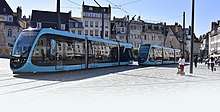
A tramway commenced service in September 2014. The length of the line is 13 kilometres (8.1 mi) and the route follows a mainly South-West-North East direction through the city between Hauts du Chazal and alternative destinations of Chalezeule ("parc Micaud") and the Besançon railway station at "Gare Viotte".
Bus
Bus services in Besançon and its suburbs are run by the Ginko company. It runs 58 bus lines and its fleet has about 240 buses. The network serves the 68 municipalities of the urban community.
Notable people
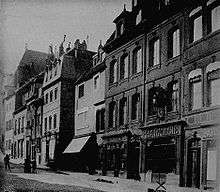
Besançon was the birthplace of:
- Claude Goudimel (1510–1572), musician, teacher of Palestrina. Composer of Protestant hymns
- Antoine Perrenot de Granvelle (1517–1586), cardinal, statesman and humanist. Counsellor of Charles V, Viceroy of Naples
- Jean-Baptiste Besard (1567 – c. 1625), lawyer, Doctor of Medicine and composer for the lute
- Jean-Baptiste Boisot (1638–1694), abbot and scholar
- Jean Mairet (1604–1686), dramatist
- Michel Blavet (1700–1768), flutist, composer
- Charles Fourier (1772–1837), inventor of socialist "phalansteries" (vast communal buildings surrounded by a highly cultivated agricultural area)
- Charles-Étienne-François Ruty (1777–1828), comte, general, peer—commissioned into the army in 1793 and promoted to lt. general in 1813
- Charles Weiss (1779–1866), librarian and bibliographer
- Charles Nodier (1780–1844), writer. Leader of the Romantic movement
- Jean Claude Eugène Péclet (1793–1857), physicist, gave his name to the Péclet number
- Victor Hugo (1802–1885), writer and poet
- Pierre-Joseph Proudhon (1809–1865), politician, economist and author, theorist of anarchism
- Adolphe Braun (1812–1877), early photographer
- Marie Louise Outhwaite (née Roget) (1814–1905), prominent early settler of Auckland, New Zealand.
- Hilaire de Chardonnet (1838–1924), inventor of artificial silk
- Henry Aron (1842–1885), journalist[16]
- Louis-Jean Résal (1854–1920), engineer who built the Pont Mirabeau and the Pont Alexandre III in Paris
- Auguste and Louis Lumière (1862–1954) and (1864–1948), inventors of cinematography
- Émile Scaremberg (1863–1938), tenor
- Tristan Bernard (1866–1947), journalist and humorist
- Albert Seitz (1872–1937), composer and violist
- Ludovic Arrachart (1897–1933), aviator
- Jean de Gribaldy (1922–1987), professional racing cyclist and directeur sportif
- Bernard Blum (1938–2014), agronomist and founder of IBMA and ABIM
- Philippe Bender (born 1942), flutist and conductor
- Raymond Blanc (born 1949), chef
- Marie-Louise Paris (1889–1969), French engineer who founded the Women's Polytechnic
- Thomas Paris (born 1970), author
- Morrade Hakkar (born 1972), boxer
- Sylvie Mamy, musicologist
- Gaspard Augé (born 1979), one half of electronic music duo Justice
- Cyril Kali, footballer
- Yohann Lasimant, footballer
- Lucien Laurent, footballer
King Willem-Alexander of the Netherlands is also the Lord of Besançon.
Literary references
- Julius Caesar, in his account Commentarii de Bello Gallico gives a description of the antique city of Besançon, named Vesontio (first book, section 38):
[1.38] When he had proceeded three days' journey, word was brought to him that Ariovistus was hastening with all his forces to seize on Vesontio, which is the largest town of the Sequani, and had advanced three days' journey from its territories. Caesar thought that he ought to take the greatest precautions lest this should happen, for there was in that town a most ample supply of every thing which was serviceable for war; and so fortified was it by the nature of the ground, as to afford a great facility for protracting the war, inasmuch as the river Doubs almost surrounds the whole town, as though it were traced round it with a pair of compasses. A mountain of great height shuts in the remaining space, which is not more than 600 feet (180 m), where the river leaves a gap, in such a manner that the roots of that mountain extend to the river's bank on either side. A wall thrown around it makes a citadel of this [mountain], and connects it with the town.
- Gary Jennings's novel Raptor, which takes place in the 5th century AD, describes Vesontio lavishly.
- In Stendhal's novel Le rouge et le noir, Julien Sorel, the main character, studies for a while at the Catholic seminary at Besançon (first book, chapters 24 to 30):
Eventually he saw the white walls beyond the distant mountain; it was the citadel of Besançon. "What a difference", he said, sighing, "if I could come into this fine city as a sub-lieutenant of one of these regiments of the post." Besançon is not only one of the prettiest cities in France, but it abounds in brave and intelligent men. Julien, however, was only a little peasant, without any means of approaching distinguished personages.
- In the poem This century was two years old (Les Feuilles d'automne; literally – "The Leaves of Autumn"), Victor Hugo evokes his birth in Besançon:
This century was two years old. Rome was replacing Sparta;
Already Napoleon was emerging from under Bonaparte.
And already the First Consul's tight mask
Had been split in several places by the Emperor's brow.
It was then that in Besançon, that old Spanish town,
Cast like a seed into the flying wind,
A child was born of mixed blood—Breton and Lorraine—
Pallid, blind and mute,...
That child, whom Life was scratching from its book,
And who had not another day to live,
Was me.
- Julian Barnes's novel A History of the World in 10 1⁄2 Chapters features as chapter 3: "Wars of Religion"—a fictional manuscript reportedly from the Archives Municipales de Besançon.
- Balzac's novel Albert Savaron takes place in Besançon.
- Colonel Sainte-Hermine, the fictional hero of Alexandre Dumas' The Last Cavalier, is a native of Besançon.
The Christmas carol "Berger, Secoue Ton Sommeil Profond", known in English as "Shepherds, Shake Off Your Drowsy Sleep" originated in Besançon in the 17th century.
Twin towns – sister cities
Besançon is twinned with:[17]













See also
- Communes of the Doubs department
- List of works by James Pradier
- A statue of Henri Bouchot stands in Besançon's square Henri-Bouchot. It was originally in bronze but was melted down by the Vichy régime. The replacement in stone was executed by Georges Saupique
References
- "Populations légales 2017". INSEE. Retrieved 6 January 2020.
- "Besançon". Lexico UK Dictionary. Oxford University Press. Retrieved 18 August 2019.
- "Besançon". The American Heritage Dictionary of the English Language (5th ed.). Boston: Houghton Mifflin Harcourt. Retrieved 18 August 2019.
- "Besançon". Merriam-Webster Dictionary. Retrieved 18 August 2019.
- Considering surface green spaces per inhabitant, Numbers available on the encyclopedia site Quid, at the bottom of the page Archived 9 February 2010 at the Wayback Machine
- Caesar & BG, Book I, Section 12.
- Strabo, Geography 4.3.2
- Shakespeare, Nicholas (2013) Priscilla: The Hidden Life of an Englishwoman in Wartime France. (Harvill Secker).
- "Climatological Information for Besançon, France". Meteo France. 14 February 2019.
- "Besançon (25)" (PDF). Fiche Climatologique: Statistiques 1981–2010 et records (in French). Meteo France. Retrieved 14 February 2019.
- "Normes et records 1961–1990: Besançon – altitude 307m" (in French). Infoclimat. Retrieved 14 February 2019.
- "Institut Supérieur d'Ingénieurs de Franche-Comté (Besançon) web site". Retrieved 20 June 2011.
- http://www.coulouris.net/george-jean/tandemfrance2003/besancon/Images/9.jpg
- http://www.kunsttrip.nl/images/besancon/facade%20van%20het%20palais%20granvelle%20becancon.jpg
- http://familledoderen.canalblog.com/images/besancon_palais.jpg
- Dupré, Romain (February 2013). "Henri, dit Henry, Aron, professeur, publiciste, directeur du Journal officiel". Archives Juives, Revue d'histoire des Juifs de France, Vol. 46, pp. 136-140. Retrieved 24 January 2016 (subscription required for full access) (in French).
- "Besançon, ville ouverte au monde". grandbesancon.fr (in French). Besançon. Retrieved 12 November 2019.